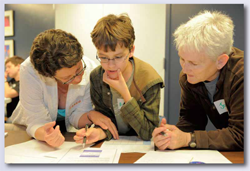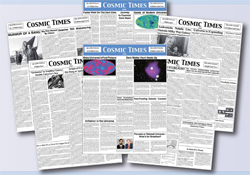NICER E/POOverviewThe NICER Principal Investigator, scientists, and engineering teams are committed to a strong E/PO program that addresses the NASA Science Mission Directorate (SMD) goals of attracting and retaining students in STEM disciplines, contributing to public literacy in science and technology, and augmenting the scientific and technical workforce needed to achieve NASA's mission. Through a robust and diverse E/PO portfolio, the NICER mission will educate and engage students, educators, and the general public in its exciting discoveries, which will revolutionize our understanding of neutron stars and pulsar timing while changing the way we navigate the universe. Program Highlights
Space Forensics The Space Forensics program is a cornerstone project within the Physics of the Cosmos/Cosmic Origins E/PO effort, also managed within Goddard's Astrophysics Science Division. Space Forensics takes audiences through astronomy problem-solving narratives that parallel crime scene forensics, offering packages of classroom activities (aligned with current national education standards) about each mystery as well as an interactive website to make these cases available to a broader public audience. Current cases cover topics such as supernovae, black holes, gravitational waves, and gamma-ray bursts. A NICER-themed case will be added to the Space Forensics repertoire and disseminated through the program's website and educator network. In particular, neutron stars (especially pulsars) offer a variety of interesting mysteries (historical and current) that educators, students, and the general public can explore through examination of NASA data. 
Family Science Night (FSN) is a program for middle school students and their families, developed and pilot-tested at Goddard Space Flight Center and now disseminated to a network of nationwide educational providers. The program allows parents and students to work together, learning science content and problem-solving techniques as part of an engaging, on-going program during out-of-school hours. The NICER E/PO team will create a new session to complement the existing portfolio of FSN sessions, which span a diverse range of topics from basic scientific processes to specific astronomical concepts. Prospective topics include an engineering session about designing payloads with specific goals and limitations (such as NICER has to consider for ISS deployment), or a session that explores navigation concepts from the basics (such as GPS, triangulation, and sextants) to the cutting-edge XNAV technology. 
Cosmic Times is a series of curriculum support materials developed by the ASD E/PO team for middle school and high school classrooms that trace the history of our understanding of the universe during the past 100 years, from Einstein's formulation of gravity to the discovery of dark energy. It consists of 6 posters, each resembling the front page of a newspaper from a particular time in this history, with articles describing the discoveries, supported by classroom activities and online content. Based on the success of these resources, which are being used in classrooms around the country, the NICER E/PO team will develop a smaller-scale series of articles and activities about the history of navigation - snapshots in time from the original sextants to XNAV's innovations. |


